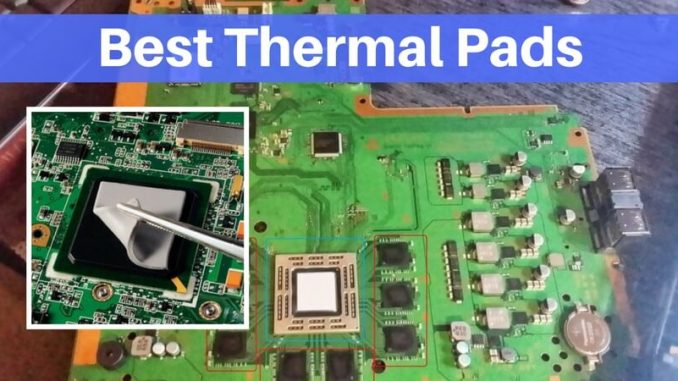
CPU Fans are a great way to dissipate heat from your CPU, but they sometimes leave something to be desired. They’re noisy and the fan speed can be inconsistent. In addition, they can cause annoying dust build up over time. Utilizing a CPU thermal pad instead of a CPU fan is an excellent way to combat these issues. CPU thermal pads are more or less silent and allow for even more control than a fan does. Plus, they don’t generate as much dust as a fan does. Here’s our guide on how to select the best cpu thermal pad for installation!
Why choose a CPU thermal pad?
CPU fans are noisy and inconsistent. They also generate dust over time. And while dust may not seem like a big deal, it can be given enough time. Dust particles will eventually clog your fan and cause the motor to stop spinning.
The best thing about a CPU thermal pad is that they’re silent and more consistent than a fan is. In addition, they don’t generate any dust at all, so you’ll have much less to worry about in regards to maintenance.
Advantages of using a CPU thermal pad
CPU fans are noisy, inefficient, and can cause dust buildup over time. The alternative to using a fan is using a CPU thermal pad. Here are some of the many benefits of using a CPU thermal pad:
- They’re silent
- They allow for more control than a fan does
- They don’t generate as much dust as a fan does
Disadvantages of using a CPU thermal pad
The only disadvantage to CPU thermal pads is the initial cost. CPU fans are often cheaper than CPU thermal pads so if you’re on a budget, they may be your best option. However, if you’re looking for something that’s more efficient and doesn’t generate as much dust, then the higher upfront cost of a CPU thermal pad is worth it.
What to look for in a CPU thermal pad?
If you’re looking for a CPU thermal RO Service in Gurgaon, there are some things to consider before buying.
– What is your budget?
– How much heat do you produce?
The first thing to think about when buying a CPU thermal pad is your budget. There are many different types of pads out there, and they vary in price depending on their size and material type. The more expensive the pad, the better the quality will be. If you need something quickly, then you can get an inexpensive pad. However, if you want an even better experience with less noise and dust build up, then it may be worth getting a more expensive one.
The second thing to consider is how much heat your computer produces. This will affect how large of a surface area you need to cover to dissipate all that heat effectively. If you only have minimal heat production, then an inexpensive pad should suffice. But if your computer produces a lot of heat – like during intense gaming sessions – then it’s best not to skimp out on the budget or size of the pad because it’ll probably just cause problems in the future if it’s not enough.
Thickness
There are two thicknesses of CPU thermal Pest Control Meerut. The first is a thinner thermal pad, which is usually less expensive. Thicker thermal pads, on the other hand, are often more expensive because they take up more surface area and provide better cooling.
Density
The first thing you’ll want to consider is the density of the thermal pad. In general, a higher density will provide more effective cooling, but it’s also heavier and takes up more space. If you’re looking for something that packs a punch without being too heavy or bulky, a medium-density pad will be your best bet.
Thermal Conductivity
The thermal conductivity of your CPU thermal pad will play a major role in the effectiveness of the product. The higher the thermal conductivity, the more effective it will be at transferring heat away from your CPU.
There are four types of materials that are used for making CPU pads: ceramic, copper, aluminum, and silver. Copper is your best option as it has one of the highest thermal conductivities on the market. It does not generate static electricity which is another bonus!
Compatible CPUs.
If you have a compatible CPU, a CPU thermal pad is a great way to go. If you have a compatible CPU, you want to make sure that the pad is specifically made for your CPU. You don’t want to use one that was designed for a different CPU as it may not work as intended.
Another key thing to remember is that the pad needs to be compatible with your motherboard’s sockets. The sockets are different on all motherboards, so make sure you check if your motherboard uses a standard or LGA socket first before buying a pad.
What is the Difference between CPU Coolers and CPU Pads?
When you buy a CPU cooler, it is designed to be a more efficient heat-sink for your CPU. Coolers are usually made up of aluminum or copper and have fans to keep your CPU cool as well as reduce noise. Coolers are also designed to fit snugly on your motherboard’s sockets, so they don’t move around when you install them.
On the other hand, when you buy a thermal pad, it is not designed to be used with the cooling system of your CPU. Thermal pads are usually made up of ceramic or copper and have no fans. Instead, thermal pads use conductive paste that transfers heat away from your CPU and into the pad itself. This allows more heat to dissipate and prevents the CPU from overheating.
Thermal pads are also designed to fit snugly on your motherboard’s sockets, so they don’t move around when you install them.
Which Type of Thermal Pad Should I Buy?
The first thing you need to decide is whether you want a thermal pad for your CPU or a CPU cooler for your CPU. If you’re looking for something that will keep your CPU cool, then look for a cooler type of thermal pad. On the other hand, if you want something that will dissipate heat away from your CPU, then go ahead and get a thermal pad instead.
If you’re unsure about what type of product is best for you, we recommend checking out our list of top rated coolers and thermal pads. It will help you decide which is best for your needs.
How to Install a Thermal Pad
First of all, you need to have your thermal pad ready and installed on your CPU before you start installing the cooler. Then, follow these steps:
Step 1: Take off the protective film from the back of your cooler and place it on top of your motherboard’s CPU socket. After that, take out the thermal pad from its packaging.
Step 2: Put a small amount of thermal paste on the center of the pad, then press it into place on top of your CPU’s surface. If there is any excess paste left over, just put it in a container for later use.
Step 3: Slide the cooler over the top of your CPU and attach it to the back of your motherboard. Then, screw in the screws that come with your cooler.
Step 4: Now, you’re ready to test out your new cooler. Just turn on your computer and see if it’s working correctly!






